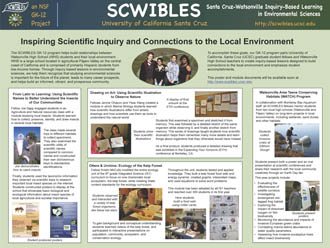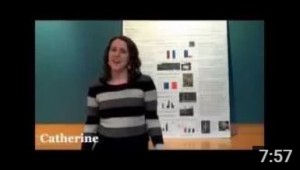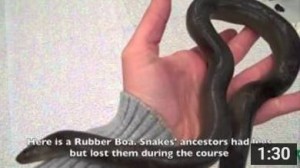Here are other products from the SCWIBLES program, including publications and poster presentations on inquiry-based education, videos that accompany modules, and scholarly publications from our Fellows
| Click to go to: | Program Publications |
| Fellows’ Module Videos | |
| Fellows’ Science Publications |
| Program Publications |
| Bryce CM, Baliga VB, de Nesnera KL, Fiack D, Goetz K, Tarjan LM, Wade C, Yovovich V, Baumgart S, Bard DG, Ash D, Parker IM, and Gilbert GS. 2016. Models in the NGSS Biology Classroom. The American Biology Teacher 78(1). In Press. |
Tarjan, LM, de Nesnera, KL & Hoffman R. 2015. Authentic science investigation in the classroom: Tools for creating original testable questions and graphical hypotheses. Science Scope.
Fellows’ Module Videos
Fellows collaborated with teachers to produce video clips that serve as an introduction for students on topics covered in the various learning modules. Access these videos by clicking on the image below or going directly to the SCWIBLES YouTube channel.
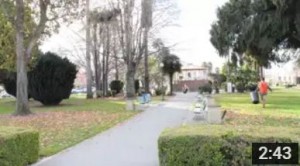 “What’s Your Walk Score: Walkable neighborhoods as healthy, social and safe communities”. Students, particular those in low income communities, are increasingly faced with poor nutrition and exercise options. One way to combat this while also building community is to teach about walkable communities. |
||
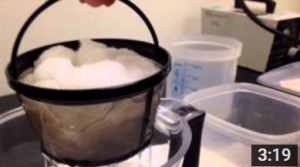 Oil Pollution Solutions. A video to accompany an inquiry based educational activity (module) used in the SCWIBLES program. Created by Kristin de Nesnera. |
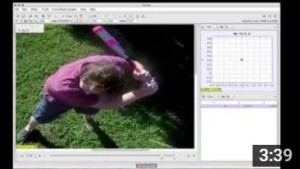 Physics of Motion: How far can you hit the ball? A SCWIBLES video that explains the use of “Tracker”, a free software app. Tracker allows you to gather physics data on the motion of any moving object seen in a video. |
|
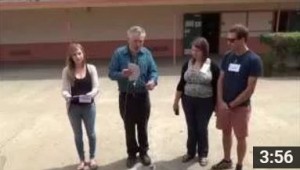 Round & Round It Goes: Getting dizzy in geosynchronous orbit. A SCWIBLES video used as an intro to the Geosynchronous Orbit module created by Caleb Bryce and Stephen Buchter. |
||
 Size Matters: Understanding the surface area-to-volume ratio. Fellows Kim Goetz and Caleb Bryce produced this video explaining the concept of surface area to volume. A diffusion experiment using colored agar cubes, and various real life examples are used to help students understand this concept. |
 What’s Stomata With You?: Using leaf epidermal peels to determine stomatal density. Fellow Catherine Wade produced this video to explain the concepts behind leaf stomata and their importance in regulating water loss in plants. |
|
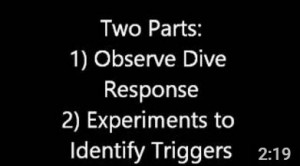 Hold your breath! Fellow Vikram Baliga produced this video to accompany his Dive Response module for inquiry-based education in high school science lab. |
||
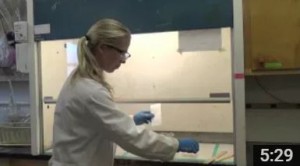 Colors in Chemistry! Using paper chromatography to understand polarity. A SCWIBLES video to accompany our hands-on inquiry-based module on paper chromatography developed by Fellows Rachel Zuercher and Chandra Goetsch. |
| Fellows’ Science Publications |
|
Bryce CM, Baliga VB, de Nesnera KL, Fiack D, Goetz K, Tarjan LM, Wade C, Yovovich V, Baumgart S, Bard DG, Ash D, Parker IM, and Gilbert GS. 2016. Models in the NGSS Biology Classroom. The American Biology Teacher 78(1). In Press. Tarjan, LM, de Nesnera KL & Hoffman R. 2015. Authentic science investigation in the classroom: Tools for creating original testable questions and graphical hypotheses. Science Scope. In Press. Jenkins, J. 2015. Contested terrain of extractive development in the American west: Using a regional political ecology framework to understand scale, biocentric conservation values, and anthropocentric resource utility. Journal of Political Ecology 22. In Press. Wilmers, C. C., Nickel, B., Bryce, C.M., Smith, J.A., Wheat, R., V. Yovovich. 2015. The golden age of biologging: how animal-borne sensors are advancing the frontiers of ecology. Ecology 96: 1741–1753. In Press. PDF Jenkins, J. 2015. Review of “Gambling on Ore: the nature of metal mining in the United States, 1860-1910”, by Kent A. Curtis. Journal of Material Culture 20. In Press. Baliga VB, and Law, CJ. 2015. Cleaners among wrasses: Phylogenetics and evolutionary patterns of cleaning behavior within Labridae. Molecular Phylogenetics and Evolution. In Press. PDF Aguilera, Stacy E., Jennifer Cole, Elena M. Finkbeiner, Elodie Le Cornu, Natalie C. Ban, Mark H. Carr, Joshua E. Cinner, Larry B. Crowder, Stefan Gelcich, Christina C. Hicks, John N. Kittinger, Rebecca Martone, Daniel Malone, Carrie Pomeroy, Richard M. Starr, Sanah Seram, Rachel Zuercher, Kenneth Broad. 2015. Managing Small-Scale Commercial Fisheries for Adaptive Capacity: Insights from Dynamic Social-Ecological Drivers of Change in Monterey Bay. PloS one 10(3): 10.1371/journal.pone.0118992 PDF Jenkins, J., Boone, K., Bosworth, K., Lehman, J., and T. Loder. 2015. Boom and bust methodology: Opportunities and challenges with conducting research at sites of resource extraction. The Extractive Industries and Society. In Press PDF Loik ME, Griffith AB, Alpert H, Concilio AL, Wade CE, Martinson SJ. 2015. Impact of intra- inter-annual snow depth variation on water relations and photosynthesis for two Great Basin Desert shrubs. Oecologia. 178(2): 403-414. Link to abstract Paola Bouley, Alicia Calle, Sharifa G. Crandall, Robert B. Davenport, Karen D. Holl, Jeffrey S. Jenkins, Josephine C. Lesage, Elissa M. Olimpi, Chad L. Oliver, Sarah A. Skikne and Brownen Stanford (CenTREAD Working Group, University of California, Santa Cruz). 2015. Review of “Large-scale Forest Restoration” by David Lamb. Restoration Ecology. 23(4): 501-502. Link to abstract Wang, Yiwei, Barry Nickel, Matthew Rutishauser, Caleb M. Bryce, Terrie M. Williams, Gabriel Elkaim, and Christopher C. Wilmers. 2015. Movement, resting, and attack behaviors of wild pumas are revealed by tri-axial accelerometer measurements. Movement ecology 3(1): 10.1186/s40462-015-0030-0 . Link to abstract Baliga VB, and Mehta RS. 2015. Linking Cranial Morphology to Prey Capture Kinematics in Three Cleaner Wrasses: Labroides dimidiatus, Larabicus quadrilineatus, and Thalassoma lutescens. Journal of Morphology. 276(11): 1377–1391. Link to abstract Fiack, Duran and Sheldon Kamieniecki. 2015. Stakeholder engagement in climate change policymaking in American cities. Journal of Environmental Studies and Sciences: 1-14. Link to abstract D. Fiack with Kamieniecki, S., Cahn, M., D. McCain-Tharnstrom. 2015. The Bureaucracy and Politics of Energy and Environmental Policy in the Western States in Smith, Z., and J. Freemuth (Eds). Environmental politics and policy in the West. University Press of Colorado. Elissa Olimpi and co-authors. 2015. Bats in the anthropogenic matrix: Challenges and opportunities for the conservation of Chiroptera and their ecosystem services in agricultural landscapes in Voigt, C. and T. Kingston (Eds) Bats in the Anthropocene: Conservation of bats in a changing world. Link to abstract Bastiaans, Elizabeth, Mary Jane Bastiaans, Gen Morinaga, José Gamaliel Castañeda Gaytán, Jonathon C. Marshall, Brendan Bane, Fausto Méndez de la Cruz, and Barry Sinervo. 2014. Female preference for sympatric vs. allopatric male throat color morphs in the mesquite lizard (Sceloporus grammicus) species complex.” PloS one 9(4). PDF Baliga VB, and Mehta RS. 2014. Scaling patterns inform ontogenetic transitions away from cleaning in Thalassoma wrasses. The Journal of Experimental Biology. 217: 3597-3606. Link to abstract Williams, Terrie M., Lisa Wolfe, Tracy Davis, Traci Kendall, Beau Richter, Yiwei Wang, Caleb Bryce, Gabriel Hugh Elkaim, and Christopher C. Wilmers. 2014. Instantaneous energetics of puma kills reveal advantage of felid sneak attacks. Science 346(6205): 81-85. Link to abstract Sinervo, B., F. Méndez-de-la-Cruz, D.B. Miles, B. Heulin, E. Bastiaans, M. Villagrán-Santa Cruz, R. Lara-Resendiz, N. Martínez-Méndez, M.L. Calderón-Espinosa, R.N. Meza-Lázaro, H. Gadsden, L.J. Avila, M. Morando, I.J. De la Riva, P. Victoriano Sepulveda, C.F. Duarte Rocha, N. Ibargüengoytía, C. Aguilar Puntriano, M. Massot, V. Lepetz, T.A. Oksanen, D.G. Chapple, A.M. Bauer, W.R. Branch, J. Clobert, and J.W. Sites, Jr. 2010. Erosion of Lizard Diversity by Climate Change and Altered Thermal Niches. Science 328(5980): 894-899. Link to abstract |


